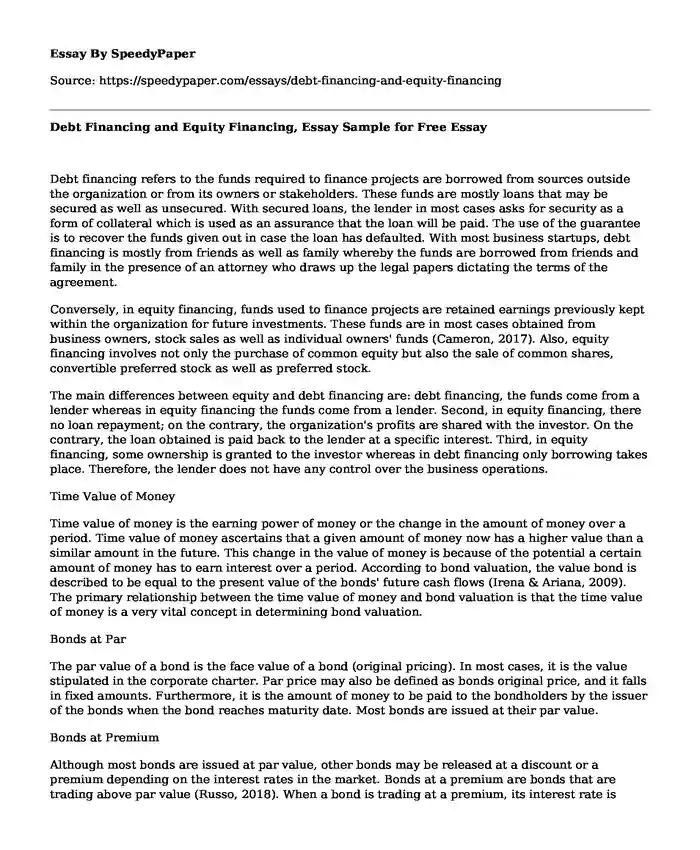Debt financing refers to the funds required to finance projects are borrowed from sources outside the organization or from its owners or stakeholders. These funds are mostly loans that may be secured as well as unsecured. With secured loans, the lender in most cases asks for security as a form of collateral which is used as an assurance that the loan will be paid. The use of the guarantee is to recover the funds given out in case the loan has defaulted. With most business startups, debt financing is mostly from friends as well as family whereby the funds are borrowed from friends and family in the presence of an attorney who draws up the legal papers dictating the terms of the agreement.
Conversely, in equity financing, funds used to finance projects are retained earnings previously kept within the organization for future investments. These funds are in most cases obtained from business owners, stock sales as well as individual owners' funds (Cameron, 2017). Also, equity financing involves not only the purchase of common equity but also the sale of common shares, convertible preferred stock as well as preferred stock.
The main differences between equity and debt financing are: debt financing, the funds come from a lender whereas in equity financing the funds come from a lender. Second, in equity financing, there no loan repayment; on the contrary, the organization's profits are shared with the investor. On the contrary, the loan obtained is paid back to the lender at a specific interest. Third, in equity financing, some ownership is granted to the investor whereas in debt financing only borrowing takes place. Therefore, the lender does not have any control over the business operations.
Time Value of Money
Time value of money is the earning power of money or the change in the amount of money over a period. Time value of money ascertains that a given amount of money now has a higher value than a similar amount in the future. This change in the value of money is because of the potential a certain amount of money has to earn interest over a period. According to bond valuation, the value bond is described to be equal to the present value of the bonds' future cash flows (Irena & Ariana, 2009). The primary relationship between the time value of money and bond valuation is that the time value of money is a very vital concept in determining bond valuation.
Bonds at Par
The par value of a bond is the face value of a bond (original pricing). In most cases, it is the value stipulated in the corporate charter. Par price may also be defined as bonds original price, and it falls in fixed amounts. Furthermore, it is the amount of money to be paid to the bondholders by the issuer of the bonds when the bond reaches maturity date. Most bonds are issued at their par value.
Bonds at Premium
Although most bonds are issued at par value, other bonds may be released at a discount or a premium depending on the interest rates in the market. Bonds at a premium are bonds that are trading above par value (Russo, 2018). When a bond is trading at a premium, its interest rate is higher than current interest rates for new bonds.
Discounted Bonds
Discounted bonds are bonds that are trading below the par value. At low interest rates, a majority of bonds will trade at a premium as well as above par. When a bond is selling at a discount, its interest rate is lower than the market interest rate for new bonds.
Difference between Coupon Rate and Market Rate
Coupon rate may be described as the periodic interest paid on the bonds par value by the issuer of the bond. In most cases, the coupon rate not similar to the rate of interest because coupon rate is calculated form par value and not the market price. Subsequently, the coupon rate determines the possibility of a bond to trade at below par, at par as well as above par value. These coupon rates may be made semiannually or annually to bondholders (Zipf, 2002).
Conversely, market rates are rates that are paid on the market price of a bond. These rates may increase when investors sense the possibility of inflation occurring. Consequently, the investors demand higher interest rates for these bonds leading to an increase in interest rates. Moreover, market rates tend to decrease when economic activity slows down which translates to reduced bond ownership.
References
Cameron, A. (2017, August). What is the difference between equity financing and debt financing? | Accounting Coach. Retrieved from: https://www.accountingcoach.com/blog/equity-financing-debt-financing
Irena, M., & Ariana, B. M. (2009). Time Value of Money and Evaluating Investments. Financial Management and Accounting Fundamentals for Construction, 161-197. doi:10.1002/9780470548813.ch7
Zipf, R. (2002). How the bond market works. New York: New York Institute of Finance.
Cite this page
Debt Financing and Equity Financing, Essay Sample for Free. (2022, Feb 22). Retrieved from https://speedypaper.net/essays/debt-financing-and-equity-financing
Request Removal
If you are the original author of this essay and no longer wish to have it published on the SpeedyPaper website, please click below to request its removal:
- Why Are Internal Audits Important? Essay Example
- Law Essay Example on Commonwealth
- Essay Example: Tennis Is My Favourite Sport
- Understanding the Teenage Brain, Essay Example
- Democracy Now - Free Essay about the News Program
- Free Essay on Homeland Security and Terrorism
- Essay Sample on Company Competitiveness
Popular categories





